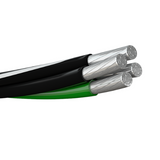How Many Amps Can 2 AWG Wire Handle?
The 2 AWG wire ampacity depends on factors like the type of conductor (aluminum or copper), thickness of wire, and temperature. For copper wires like THHN/THWN-2 and RHW at 75°C, the rating is 115A. The ampacity of 2 AWG wire is 130A at 90°C for XHHW-2 and USE. Aluminum types like RHW and THWN are rated 90A at 75°C and 100A at 90°C for RHW-2 and THWN-2. For older or more specialized types like TW and UF, the amp rating at 60°C is 75A.
Understanding the ampacity of 2 AWG wire includes factors such as conductor material, temperature, and insulation type. These ratings, as outlined by the National Electrical Code (NEC), guide the safe and efficient utilization of 2 AWG wire across various applications.

What is 2 AWG wire used for?
2 AWG (American Wire Gauge) wire is a large-diameter wire primarily used in electrical systems that require substantial current-carrying capacity. It is designed for high-current applications , including large electrical power feeds and big amplifier installations.
Let’s review some of the common 2 AWG wire applications:
- Service Entrances. 2 AWG wire establishes a connection between the utility's power source and homes or buildings. The exact capacity of 2 AWG wires depends on the insulation type, installation methods, etc, but 2 AWG’s copper wire capacity is usually enough for most residential homes. Sometimes, the houses have a dual service entrance, which requires use of 2 AWG wires.
- Large Circuit Loads. 2 AWG wire is suitable for managing demanding electrical loads, such as air conditioners and heaters because of its diameter and high conductivity..
- Backup Power Supplies, RVs, Solar Setups. 2 AWG wire ensures the connection between backup power sources, solar panels, batteries, and essential systems. It can carry substantial currents over distances and helps optimize energy transfer efficiency. In this way, there’s power supply during off-grid situations.
- Grounding. 2 AWG wire provides a reliable and low-resistance pathway for electric currents during potential faults or emergencies. This path for excess electricity redirects it away from sensitive components and structures, preventing damage and reducing the risk of fires or electrical hazards.
- Welding. 2 AWG wire allows for effective metal joining processes. It can transmit high currents efficiently and ensures that welding equipment generates the necessary heat to melt and fuse metals together. 2 AWG wire is used for high-amperage welding applications, such as pipeline construction, bridge construction, etc.
- Amplifier Installations. 2 AWG wire delivers ample power to drive speakers and achieve optimal sound quality. Whether it’s a home entertainment system or professional sound setup, 2 AWG wire is widely used across these settings because it contributes to clear and immersive sound reproduction.
- Renewable Energy Systems. 2 AWG wire connects components within solar or wind energy systems. This wire size ensures that renewable energy sources contribute effectively to the overall energy supply. Specifically, 2 AWG wire links solar panels, wind turbines, charge controllers, and inverters, addressing the demands of high current flow.
- Marine Industry. 2 AWG wire distributes power throughout boats and ships. It supports systems such as navigation equipment, lighting, communication tools, and more.
- Automotive Industry. 2 AWG wire transmits power within vehicles. In the automotive industry, it is used in lights, electronics, ignition components, and more. It ensures reliable connections between battery terminals, engine components, and electrical systems.
- Industrial Machinery. 2 AWG connects heavy machines to power sources and leads to the reliable transmission of electricity needed for various industrial processes. 2 AWG wire is used in connecting motors, drives, control panels, and sensors.
Common Types of 2 AWG Wires
2 AWG wires come in different forms and types. Some of the most popular types are:
- THHN/THWN. Suitable for general wiring in conduit or cable trays. 2 AWG THHN is used in subpanels, large motors, and HVAC systems.
- XHHW/XHHW-2. Resistant to moisture and heat, commonly used in conduit systems for indoor and outdoor applications. 2 AWG XHHW/XHHW-2 are used for feeder circuits, generator connections, data centers, etc.
- USE (Underground Service Entrance) Cable. Designed for direct burial in the ground, commonly used for outdoor power distribution to detached structures. For example, 2 AWG USE are used for outdoor lighting and fixtures, irrigation systems, mobile homes and RV parks.
- Welding Cable. Welding cables are primarily used for welding purposes, but can also be used for other heavy -duty tasks.
- Battery cable is mainly used for connecting vehicle, boat, and other object batteries, these cables serve as a dependable means of transmitting power. It’s also used in RVs and campers, golf carts, recreational vehicles, etc.
- Bare Copper wire is used for grounding systems, electrical grids, lightning protection, and radio frequency shielding, etc.
- Service Entrance (SE) Cable. Used for connecting power from the utility to homes or buildings, ensuring efficient electricity distribution. It’s also used in emergency and backup generators, subpanels, and mobile homes.
- Marine Cable: Engineered to withstand the challenges of marine environments, these cables are specifically designed to endure harsh weather conditions including sun exposure and saltwater exposure. They are widely used in marine environments since they can ensure reliable power distribution across boats and ships. Marine cables are also used in solar panels and wind generators, heating and cooling systems, etc.

































